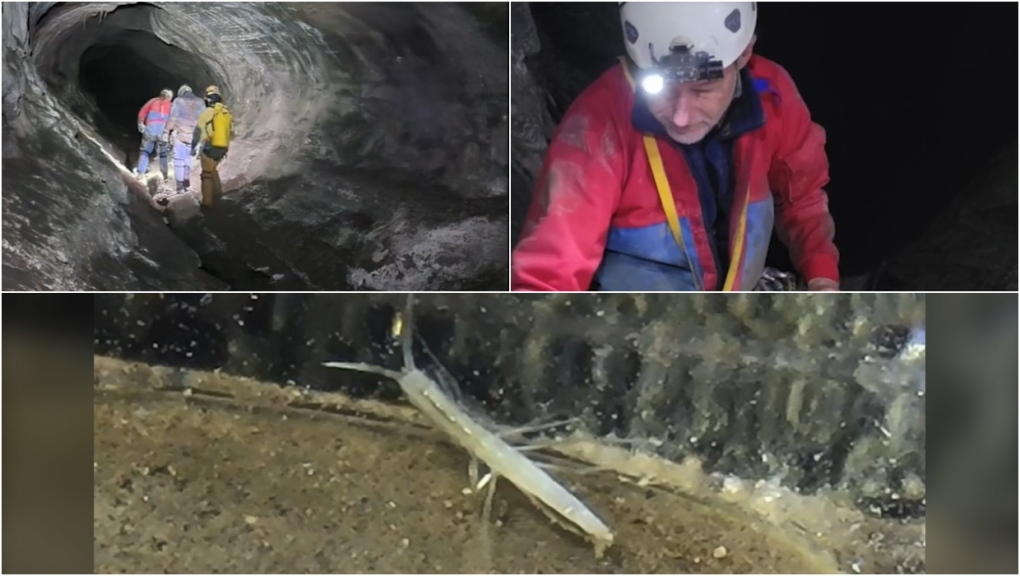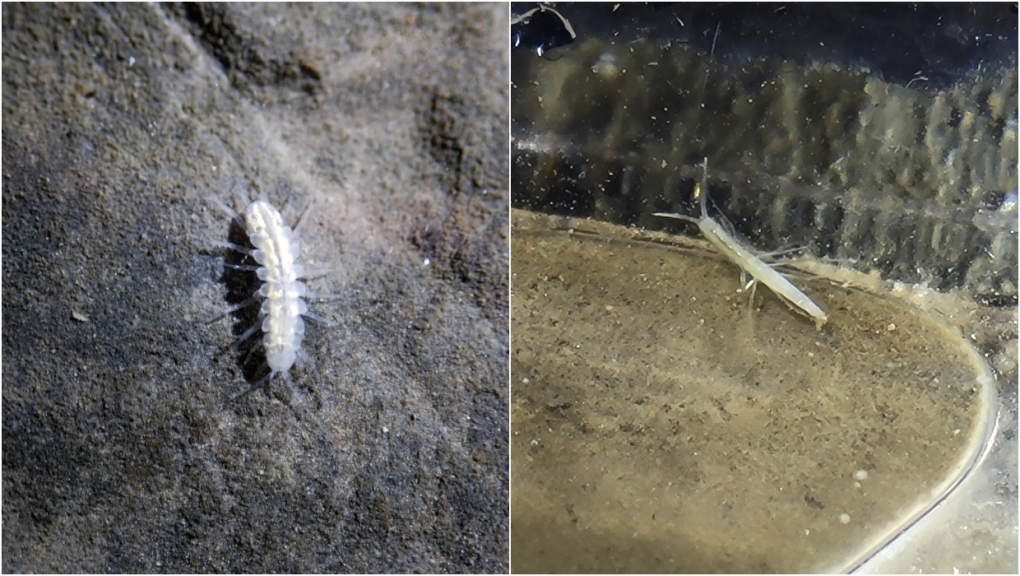Banff National Park cave creature exists 'no where else': Parks Canada
 A cave in Banff National Park has been recognized as a globally significant Key Biodiversity Area (KBA) thanks to the freshwater amphipod crustacean found inside. (KBA program)
A cave in Banff National Park has been recognized as a globally significant Key Biodiversity Area (KBA) thanks to the freshwater amphipod crustacean found inside. (KBA program)
A cave in Banff National Park has been recognized as a globally significant location thanks to a tiny creature found inside.
The freshwater amphipod crustacean, known as the Castleguard Cave amphipod (Stygobromus canadensis), is largely transparent and looks like a miniscule shrimp, but it's hugely important.
"This tiny cave-dwelling organism is only found in Castleguard Cave, and no where else on the planet," said Anne Forshner, Parks Canada species of concern ecologist.
It's because of the amphipod that Castleguard Cave has recognized as a Key Biodiversity Area (KBA).
"Scientists still don’t know a great deal about this particular amphipod, which has somehow survived for millennia in this cold, nutrient poor and frequently flooded environment, but its uniqueness made this site a prime candidate for KBA status," said Parks Canada in a news release.
 A cave in Banff National Park has been recognized as a globally significant Key Biodiversity Area (KBA) thanks to the freshwater amphipod crustacean found inside. (Wildlife Conservation Society Canada)Located in the north end of Banff National Park, Castleguard Cave is a limestone cave that features one Canada's longest known cave systems – 21 kilometres in length.
A cave in Banff National Park has been recognized as a globally significant Key Biodiversity Area (KBA) thanks to the freshwater amphipod crustacean found inside. (Wildlife Conservation Society Canada)Located in the north end of Banff National Park, Castleguard Cave is a limestone cave that features one Canada's longest known cave systems – 21 kilometres in length.
"Castleguard Cave itself is a unique environment," said Forshner. "Part of the cave exists underneath the glaciers that form the Columbia Icefields, and while there is much research into glaciers, cave ecology in this part of North America is poorly understood."
The cave is located about 170 kilometres north of the Cave and Basin Historic Site.
Castleguard Cave joins two other sites in Alberta recognized by the KBA program – the Frank Lake wetland near High River, Alta. and the Peace-Athabasca Delta in northeast Alberta.
The KBA program works with governments, local conservation organizations, scientists and Indigenous Nations to collaboratively identify the places that are most critical to conserve to avoid losing a species or ecosystem.
Sites are recognized based on meeting strict criteria.
While KBAs are not designed to provide any legal protection, they are a way of identifying places in unprotected areas where conservation and stewardship efforts can have a large impact on halting and reversing the loss of nature.
More than 70 sites across Canada are listed as KBAs and more than 850 more under consideration.
To learn more you can visit the KBA Canada website.
CTVNews.ca Top Stories

BREAKING Israel attacks Iran, Reuters sources say; drones reported over Isfahan
Israel has attacked Iran, three people familiar with the matter told Reuters, as Iranian state media reported early on Friday that its forces had destroyed drones, days after Iran launched a retaliatory drone strike on Israel.
American millionaire Jonathan Lehrer denied bail after being charged with killing Canadian couple
American millionaire Jonathan Lehrer, one of two men charged in the killings of a Canadian couple in Dominica, has been denied bail.
Nearly half of China's major cities are sinking, researchers say
Nearly half of China's major cities are suffering 'moderate to severe' levels of subsidence, putting millions at risk of flooding especially as sea levels rise.
Prince Harry formally confirms he is now a U.S. resident
Prince Harry, the son of King Charles III and fifth in line to the British throne, has formally confirmed he is now a U.S. resident.
Judge says 'no evidence fully supports' murder case against Umar Zameer as jury starts deliberations
The judge presiding over the trial of a man accused of fatally running over a Toronto police officer is telling jurors the possible verdicts they may reach based on the evidence in the case.
Health Canada to change sperm donor screening rules for men who have sex with men
Health Canada will change its longstanding policy restricting gay and bisexual men from donating to sperm banks in Canada, CTV News has learned. The federal health agency has adopted a revised directive removing the ban on gay, bisexual and other men who have sex with men, effective May 8.
Colin Jost names one celebrity who is great at hosting 'Saturday Night Live'
Colin Jost, who co-anchors Saturday Night Live's 'Weekend Update,' revealed who he thinks is one of the best hosts on the show.
Sports columnist apologizes for 'oafish' comments directed at Caitlin Clark. The controversy isn't over
A male columnist has apologized for a cringeworthy moment during former University of Iowa superstar and college basketball's highest scorer Caitlin Clark's first news conference as an Indiana Fever player.
'Shopaholic' author Sophie Kinsella reveals brain cancer diagnosis
Sophie Kinsella, the best-selling author behind the 'Shopaholic' book series, has revealed that she is receiving treatment for brain cancer.
































